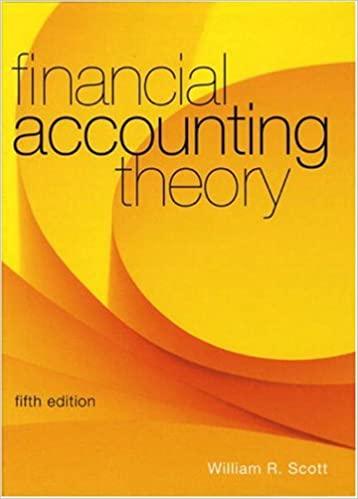Refer to Theory in Practice10.2 in Section10.6 concerning BCE Inc. Reproduced on p. 395 are the 1997
Question:
Refer to Theory in Practice10.2 in Section10.6 concerning BCE Inc. Reproduced on p. 395 are the 1997 consolidated statement of operations and Note 2 to the financial statements of BCE. The statement of operations shows an extraordinary charge of $2.950 billion for stranded costs. After this extraordinary charge, operations showed a net loss for the year of $1.536 billion.
Required
a. Does the charge for stranded costs meet the definition of an extraordinary item under Section 3480 of the CICA Handbook (see Section5.5)? Discuss.
b. Regardless of whether or not the $2.950 billion is an extraordinary item, as a member of BCE’s compensation committee would you support exclusion of the charge from earnings for the purpose of managers’ short-term incentive awards? Discuss.
c. What is the persistence of the $2.950 billion component of 1997 earnings? Your answer should be in the range [0-1]. Explain your answer.
d. On April 23, 1998, The Globe and Mail reported “Earnings results fuel BCE shares to 52-week high.” This headline refers to BCE’s record reported earnings for its first quarter, 1998, of 48 cents per share excluding “onetime items.” This is a 46% increase over 33 cents per share for the same quarter of 1997. The article quoted the CEO of BCE as saying, “We continue to see solid growth in all areas of our operations.”
According to the article, these first-quarter results suggest a good performance by BCE in 1998, after a $1.5 billion loss in 1997 due to a record $2.9 billion charge at its telephone company subsidiary.
Give another reason, in addition to ' ‘solid growth,” that may explain the record first-quarter results. As a member of the BCE compensation committee contemplating the 1998 annual short-term incentive awards, would you support basing these awards on the record first-quarter earnings? Explain your position.

Extraordinary Item As at December 31, 1997, BCE determined that most of its telecommunications subsidiary and associated companies no longer met the criteria necessary for the continued application of regulatory accounting provisions. As a result, BCE recorded an extraordinary non-cash charge of $2,950 million, net of an income tax benefit of $1,892 million and a non-controlling interest of $38 million. Also included in the extraordinary item is an after-tax charge of $97 million representing BCE’s share of the related extraordinary item of its associated companies.
The operations of most of BCE’s telecommunications subsidiary see associated companies no longer met the criteria for application of regulatory accounting provisions due to significant changes in regulation including the implementation of price cap regulation which replaced rate-of-return regulation effective January 1, 1998, and the concurrent introduction of competition in the local exchange market. Accordingly, BCE adjusted the net carrying values of assets and liabilities as at December 31, 1997, to reflect values appropriate under GAAP for enterprises no longer subject to rate-of-return regulation.
The determination by BCE that most of its telecommunications subsidiary and associated companies no longer met the criteria for the continuing application of regulatory accounting provisions is the result of a review, which began in 1997, to assess the impact of the introduction of price cap regulation coupled with the introduction of competition in the local exchange market. Before the advent of these two factors, accounting practices were based on a regulatory regime which provided reasonable assurance of the recovery of costs through rates set by the regulator and charged to customers. These regulatory accounting provisions resulted in the recognition of certain assets and liabilities along with capital asset lives which were substantially different from enterprises not subject to rate-of-return regulation.
The extraordinary charge consists of a pre-tax charge of $3,602 million related to Capital assets and a pre-tax charge of $1,181 million to adjust the carrying values of other assets and liabilities to arrive at carrying values appropriate for enterprises not subject to rate-of-return regulation. The amount of the charge related to capital assets was determined based upon an estimate of the underlying cash flows using management's best estimate assumptions concerning the most likely course of action and other factors relating to competition, technological changes and the evolution of products and services. The net carrying values of capital assets were adjusted primarily through an increase in accumulated depreciation. The primary component of the $1,181 million charge relates to the write-off of deferred business transformation and workforce reduction costs.
Step by Step Answer:






